《植物化学保护》课程教学资源(英文讲稿)Codex Alimentarius Committee on Pesticide Residues
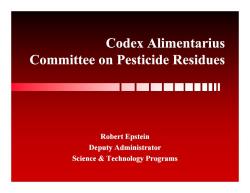
Codex Alimentarius Committee on Pesticide Residues ■■川 Robert Epstein Deputy Administrator Science Technology Programs
Codex Alimentarius Committee Committee on Pesticide Residues Committee on Pesticide Pesticide Residues Residues Robert Epstein Deputy Administrator Science Science & Technolog Programs Science & Technolog Technology Programs Programs
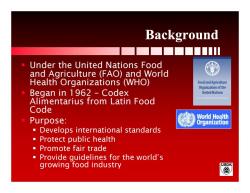
Background Under the United Nations Food and Agriculture (FAO)and World Health Organizations (WHO) Food and Agriculture Organization of the ■ Began in 1962 -Codex United Nations Alimentarius from Latin Food for a world without hunge Code Purpose: World Health Organization -Develops international standards Protect public health Promote fair trade ■ Provide guidelines for the world's growing food industry UsDA▣ @
Background Under the United Nations Food and Agriculture (FAO) and World Health Organizations (WHO) Began in 1962 – Codex Alimentarius from Latin Food Code Purpose: Develops international standards Protect public health Promote fair trade Provide guidelines for the world Provide guidelines for the world s ’ growing food industry
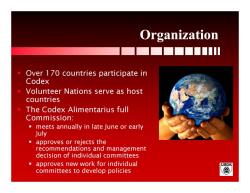
Organization ■■II Over 1 70 countries participate in Codex ■ Volunteer Nations serve as host countries ■ The Codex Alimentarius full Commission: meets annually in late June or early July "approves or rejects the recommendations and management decision of individual committees approves new work for individual USDA committees to develop policies
Organization Over 170 countries participate in Codex Volunteer Nations serve as host countries The Codex Alimentarius full Commission: meets annually in late June or early July approves or rejects the recommendations and management decision of individual committees approves new work for individual committees to develop policies
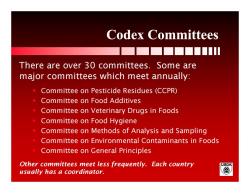
Codex Committees There are over 30 committees.Some are major committees which meet annually: Committee on Pesticide Residues (CCPR) Committee on Food Additives Committee on Veterinary Drugs in Foods Committee on Food Hygiene Committee on Methods of Analysis and Sampling Committee on Environmental Contaminants in Foods Committee on General Principles Other committees meet less frequently.Each country USDA usually has a coordinator. @
Codex Committees Codex Committees There are over 30 committees. Some are major committees which meet annually: Committee on Pesticide Residues (CCPR) Committee on Food Additives C i V i D i F d Committee on Veterinary Drugs i n Foo d s Committee on Food Hygiene Committee on Methods of Analysis and Sampling Committee on Environmental Contaminants in Foods Committee on General Principles Other committees meet less frequently. Each country usually has a coordinator
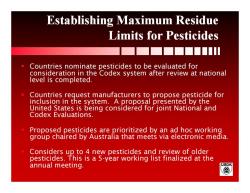
Establishing Maximum Residue Limits for Pesticides ■■■II Countries nominate pesticides to be evaluated for consideration in the Codex system after review at national level is completed. Countries request manufacturers to propose pesticide for inclusion in the system.A proposal presented by the United States is being considered for joint National and Codex Evaluations. Proposed pesticides are prioritized by an ad hoc working group chaired by Australia that meets via electronic media. Considers up to 4 new pesticides and review of older pesticides.This is a 5-year working list finalized at the annual meeting. USDA
Establishing Maximum Residue Limits for Pesticides Limits for Pesticides Countries nominate pesticides to be evaluated for consideration in the Codex system after review at national level is completed. Countries request manufacturers to propose pesticide for inclusion in the system. A proposal presented by the United States is being considered for joint National and Codex Evaluations. Pro pp p y g osed pesticides are prioritized b y an ad hoc workin g group chaired by Australia that meets via electronic media. Considers up to 4 new pesticides and review of older pesticides This is a 5 pesticides. This is a 5 -year working list finalized at the annual meeting
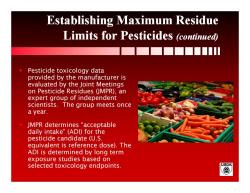
Establishing Maximum Residue Limits for Pesticides (continued 川 Pesticide toxicology data provided by the manufacturer is evaluated by the Joint Meetings on Pesticide Residues (JMPR),an expert group of independent scientists.The group meets once a year. JMPR determines "acceptable daily intake"(ADI)for the pesticide candidate (U.S equivalent is reference dose).The ADI is determined by long term exposure studies based on selected toxicology endpoints. USDA
Establishing Maximum Residue Limits for Pesticides Limits for Pesticides Pesticides (continued) (continued) Pesticide toxicology data provided by the manufacturer is evaluated by the Joint Meetings on Pesticide Residues (JMPR), an expert group of independent scientists. The group meets once a year. JMPR determines “acceptable daily intake daily intake (ADI) for the ” (ADI) for the pesticide candidate (U.S. equivalent is reference dose). The ADI is determined by long term exposure t di b d s t udies based on selected toxicology endpoints

Establishing Maximum Residue Limits for Pesticides (continued ■eII An acute reference dose is established if there is a potential acute toxic endpoint for the pesticide,based on a single or daily commodity serving Manufacturers submit to JMPR residue field trials to determine the residue levels based on Good Agricultural Practices (GAPs).The number of trials is based on USDA climate and soil conditions
Establishing Maximum Residue Limits for Pesticides Limits for Pesticides Pesticides (continued) (continued) An acute reference dose is established if there is a potential acute i d i f h toxic en dpoint for t h e pesticide, based on a single or dail y yg commodit y servin g. Manufacturers submit to JMPR residue field trials to determine the residue levels based on Good Agricultural Practices (GAPs). The numb f t i l i b d ber of t rials i s based on climate and soil conditions
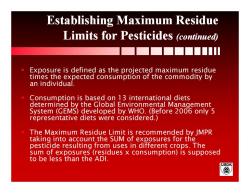
Establishing Maximum Residue Limits for Pesticides (continued) ■■■I Exposure is defined as the projected maximum residue times the expected consumption of the commodity by an individual. ■ Consumption is based on 13 international diets determined by the Global Environmental Management System (GEMS)developed by WHO.(Before 2006 only 5 representative diets were considered.) The Maximum Residue Limit is recommended by JMPR taking into account the SUM of exposures for the pesticide resulting from uses in different crops.The sum of exposures (residues x consumption)is supposed to be less than the ADl. USDA
Establishing Maximum Residue Limits for Pesticides Limits for Pesticides Pesticides (continued) (continued) Exposure is defined as the projected maximum residue times the expected consumption of the commodity by an individual an individual. Consumption is based on 13 international diets determined by the Global Environmental Management S (GEMS) d l d b WHO (B f 2006 l 5 System (GEMS) developed b y WHO. (B e fore 2006 only 5 representative diets were considered.) The Maximum Residue Limit is recommended by JMPR taking into account the SUM of exposures for the pesticide resulting from uses in different crops. The sum of exposures (residues x consumption) is supposed t b l th th ADI t o b e less than th e ADI
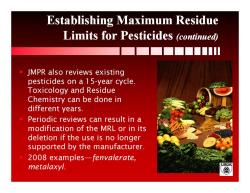
Establishing Maximum Residue Limits for Pesticides (continued JMPR also reviews existing pesticides on a 1 5-year cycle. Toxicology and Residue Chemistry can be done in different years. Periodic reviews can result in a modification of the MRL or in its deletion if the use is no longer supported by the manufacturer. 2008 examples-fenvalerate, metalaxyl. USDA
Establishing Maximum Residue Limits for Pesticides Limits for Pesticides Pesticides (continued) (continued) JMPR also reviews existing pesticides on a 15- y y ear c ycle. Toxicology and Residue Chemistry can be done in different years. Periodic reviews can result in a modification of the MRL or in its deletion if the use is no longer supported by the manufacturer. 2008 examples —fenvalerate fenvalerate, metalaxyl
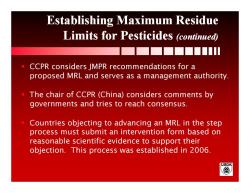
Establishing Maximum Residue Limits for Pesticides (continued) ■■I川 CCPR considers JMPR recommendations for a proposed MRL and serves as a management authority. ■ The chair of CCPR(China)considers comments by governments and tries to reach consensus. Countries objecting to advancing an MRL in the step process must submit an intervention form based on reasonable scientific evidence to support their objection.This process was established in 2006. USDA
Establishing Maximum Residue Limits for Pesticides Limits for Pesticides Pesticides (continued) (continued) CCPR considers JMPR recommendations for a proposed MRL and serves as a management authority. The chair of CCPR (China) considers comments by governments and tries to reach consensus. Countries objecting to advancing an MRL in the step process must submit an intervention form based on reasonable scientific evidence to support their objection. This process was established in 2006
按次数下载不扣除下载券;
注册用户24小时内重复下载只扣除一次;
顺序:VIP每日次数-->可用次数-->下载券;
- 《植物化学保护》课程教学资源(英文讲稿)Aquatic Plant Management.pdf
- 《植物化学保护》课程教学资源(英文讲稿)An Introduction To The Health Effects of Pesticides(PPT).ppt
- 《植物化学保护》课程教学资源(英文讲稿)Alternative Pesticides and New Developments in Pesticide Usage in Orchard Crops.pdf
- 《植物化学保护》课程教学资源(英文讲稿)A New Toxicology Testing Paradigm:Meeting Common Needs.pdf
- 《植物化学保护》课程教学资源(英文讲稿)2009 S&T Water Sampling for Pesticides.pdf
- 华南农业大学:《植物化学保护》课程教学资源(实验指导)实验七 农药残留量分析.doc
- 华南农业大学:《植物化学保护》课程教学资源(实验指导)实验四 杀虫剂药效盆栽试验.doc
- 华南农业大学:《植物化学保护》课程教学资源(实验指导)实验六 杀菌剂毒力测定.doc
- 华南农业大学:《植物化学保护》课程教学资源(实验指导)实验五 除草剂药效盆栽试验.doc
- 华南农业大学:《植物化学保护》课程教学资源(实验指导)实验二 有机磷杀虫剂抑制昆虫乙酰胆碱酯酶活性测定.doc
- 华南农业大学:《植物化学保护》课程教学资源(实验指导)实验三 杀虫剂触杀毒力(LD50)测定(点滴法).doc
- 华南农业大学:《植物化学保护》课程教学资源(实验指导)实验一 农药制剂加工与配制.doc
- 华南农业大学:《植物化学保护》课程教学资源(试卷习题)课程复习题(无答案).doc
- 华南农业大学:《植物化学保护》课程教学资源(试卷习题)试卷十四(无答案).doc
- 华南农业大学:《植物化学保护》课程教学资源(试卷习题)试卷十二(无答案).doc
- 华南农业大学:《植物化学保护》课程教学资源(试卷习题)试卷十三(无答案).doc
- 华南农业大学:《植物化学保护》课程教学资源(试卷习题)思考题(无答案).doc
- 华南农业大学:《植物化学保护》课程教学资源(试卷习题)试卷十一(无答案).doc
- 华南农业大学:《植物化学保护》课程教学资源(试卷习题)试卷十(无答案).doc
- 华南农业大学:《植物化学保护》课程教学资源(试卷习题)试卷六(无答案).doc
- 《植物化学保护》课程教学资源(英文讲稿)Considerations on Foliar Applications and Volume of Pesticides.pdf
- 《植物化学保护》课程教学资源(英文讲稿)Cross-Border Issues in Environmental Toxicology the US EPA Experience.pdf
- 《植物化学保护》课程教学资源(英文讲稿)Fungicide Use and Aerial Application.pdf
- 《植物化学保护》课程教学资源(英文讲稿)Integrated Pest Management for Urban Landscapes.pdf
- 《植物化学保护》课程教学资源(英文讲稿)IPMA Primer.pdf
- 《植物化学保护》课程教学资源(英文讲稿)Labels and Pesticide Formulations.pdf
- 《植物化学保护》课程教学资源(英文讲稿)No Spray Buffers Lawsuits & Toxicology.pdf
- 《植物化学保护》课程教学资源(英文讲稿)Oklahoma Unwanted Pesticide Disposal Program.pdf
- 《植物化学保护》课程教学资源(英文讲稿)Pesticide Toxicology(PPT).ppt
- 《植物化学保护》课程教学资源(英文讲稿)Pesticide Contamination in Rural Areas.pdf
- 《植物化学保护》课程教学资源(英文讲稿)Pesticide Formulas and Properties.pdf
- 《植物化学保护》课程教学资源(英文讲稿)Pesticide Hazards and First Aid(PPT).ppt
- 《植物化学保护》课程教学资源(英文讲稿)Pesticide Health Hazards - Exposure and Personal Protective Equipment.pdf
- 《植物化学保护》课程教学资源(英文讲稿)Pesticide Laws and Regulations.pdf
- 《植物化学保护》课程教学资源(英文讲稿)Pesticide Registration for Minor Crops and Crop Grouping Effort in Japan.pdf
- 《植物化学保护》课程教学资源(英文讲稿)Pesticide Safety and Toxicity(PPT).ppt
- 《植物化学保护》课程教学资源(英文讲稿)Pesticide Toxicity.pdf
- 《植物化学保护》课程教学资源(英文讲稿)Pesticide Toxicology and Risk Assessment.pdf
- 《植物化学保护》课程教学资源(英文讲稿)Pesticide Waste Challenges.pdf
- 《植物化学保护》课程教学资源(英文讲稿)Pesticides Analysis with the new Agilent 6220 6460 and 6530.pdf
